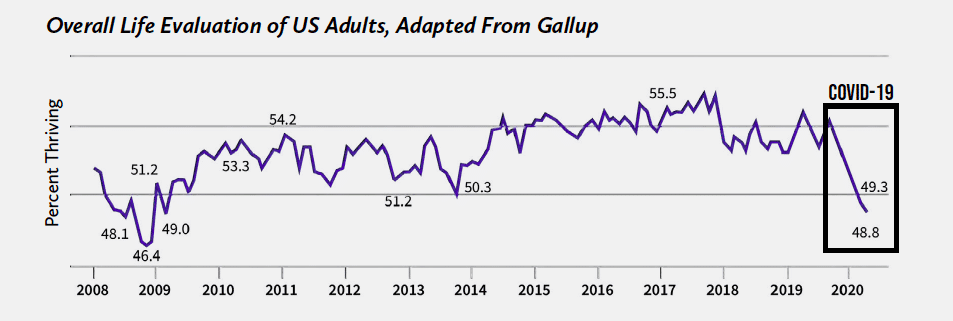
Measuring Well-Being
Cantril's Ladder of Life Evaluation
Developed in 1965, this validated tool is among the first self-evaluative measures of well-being. Cantril’s Ladder measures thriving, struggling or suffering based on a 2-item assessment. Gallop has adopted and adapted the tool and makes national-level data available to provide a pulse of our collective well-being. Cantril’s Ladder has proven exceptionally sensitive to external events such as the Great Recession and COVID-19.
Life Ratings Among Black Americans Erode During Trump Era
Americans' Life Ratings Reach Record High
A new approach
The science of thriving has informed an easy-to-use, realtime survey that measures well-being and has the ability to both catalyze change and assess progress on what matters most in communities—all people and places thriving, no exceptions. Use of these well-being measures provides an invaluable and highly-responsive complement to regular community needs assessments, population health indicators, and other social determinants of health that can take years to see measurable change. Rather than solely tracking individual health outcomes, a holistic approach that measures well-being provides a north star—one which diverse groups can rally around together.
Through either a 12- or 24-question, self-report survey, communities can get a better understanding of who in a community is thriving, struggling or suffering, and in what ways. The Institute for Healthcare Improvement, Healthy People 2030, and multi-sector partnerships around the country are leading and informing what it means to measure well-being, and to use that deeper understanding to transform neighborhoods and lives.
Getting Started Measuring Well-Being
The Well Being Assessment draws on questions that are independently validated. The Assessment itself has been administered and tested in multiple settings and applications. In order to ensure all people are thriving, the assessment can be administered with a set of demographic questions in order to stratify the results by age, race, ethnicity, gender, income, and education. A great place to start is the Implementation Guide linked below. This resource outlines how to deploy the survey, sample sizes and administration tips, and how to analyze the results. Below you’ll also find printable links to the survey for both youth and adults. The survey can be customized to account for questions you’d like to add. The implementation guide includes examples of how to modify and customize the survey.
The survey can be administered either in print, online, or verbally. It can be used in a variety of settings including schools (using the adapted youth assessment), health care settings, or community events. The survey takes just moments to complete and should be administered on a regular basis to track progress over time. The results can be analyzed using common applications such as Excel and Tableau.
Health and Well-being Measurement Approach and Assessment Guide
Well-being Assessment (Youth)
Well-being Assessment (Adult - 12 items)
Well-being Assessment (Adult 24 - items)
Trends and Geographical Variation in Population Thriving, Struggling and Suffering Across the USA, 2008–2017: a Retrospective Repeated Cross-Sectional Study
A Framework to Advance Equitable Well-being
Once you know whether and to what extent people are thriving, struggling or suffering in your community, you can identify where and how to best take action to improve well-being. The Vital Conditions for Well-Being offer a framework for understanding current community conditions and identifying the policies, practices, and investments necessary to advance equitable well-being. Examining your community through the Vital Conditions framework in conjunction with the Well-Being Survey can shed light on specific community conditions that are contributing to people thriving and/or suffering—that are likely contributing to a community’s well-being score. Essentially, the Vital Conditions can help tell the story behind the well-being score, and therefore inform a path towards improvement. The Springboard for Thriving Together (2020), organized by Vital Conditions, offers a series of actionable pivotal moves and trend-bending ideas for transforming knowledge into action and achieving widespread equitable well-being.